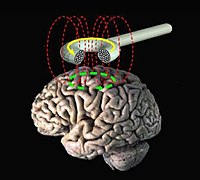
Photo from wikipedia
As we age, sleep patterns undergo severe modifications of their micro and macrostructure, with an overall lighter and more fragmented sleep structure. In general, interventions targeting sleep represent an excellent… Click to show full abstract
As we age, sleep patterns undergo severe modifications of their micro and macrostructure, with an overall lighter and more fragmented sleep structure. In general, interventions targeting sleep represent an excellent opportunity not only to maintain life quality in the healthy aging population, but also to enhance cognitive performance and, when pathology arises, to potentially prevent/slow down conversion from e.g. Mild Cognitive Impairment (MCI) to Alzheimer's Disease (AD). Sleep abnormalities are, in fact, one of the earliest recognizable biomarkers of dementia, being also partially responsible for a cascade of cortical events that worsen dementia pathophysiology, including impaired clearance systems leading to build-up of extracellular amyloid-β (Aβ) peptide and intracellular hyperphosphorylated tau proteins. In this context, Noninvasive Brain Stimulation (NiBS) techniques, such as transcranial electrical stimulation (tES) and transcranial magnetic stimulation (TMS), may help investigate the neural substrates of sleep, identify sleep-related pathology biomarkers, and ultimately help patients and healthy elderly individuals to restore sleep quality and cognitive performance. However, brain stimulation applications during sleep have so far not been fully investigated in healthy elderly cohorts, nor tested in AD patients or other related dementias. The manuscript discusses the role of sleep in normal and pathological aging, reviewing available evidence of NiBS applications during both wakefulness and sleep in healthy elderly individuals as well as in MCI/AD patients. Rationale and details for potential future brain stimulation studies targeting sleep alterations in the aging brain are discussed, including enhancement of cognitive performance, overall quality of life as well as protein clearance.
Journal Title: Ageing Research Reviews
Year Published: 2020
Link to full text (if available)
Share on Social Media: Sign Up to like & get
recommendations!